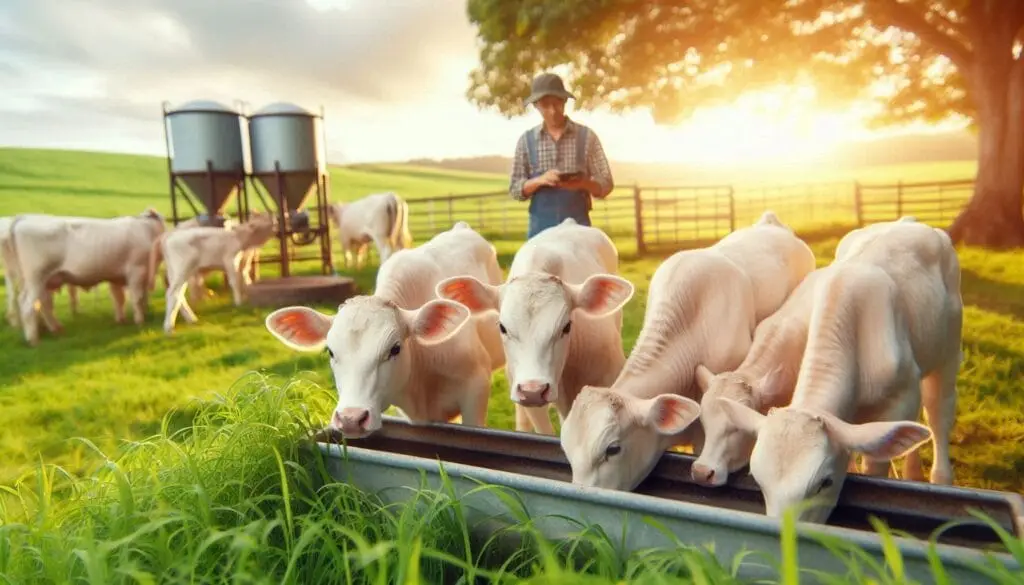Feeding Regimes for Heifers

Introduction
Feeding regimes for heifers are essential in ensuring they reach their full potential as productive dairy cows. Proper nutrition impacts growth rates, reproductive performance, and overall health. This guide will cover the nutritional needs of heifers at different stages of their development, effective feeding strategies, and the importance of monitoring growth.
Importance of Proper Nutrition
Proper nutrition during the early stages of a heifer’s life sets the foundation for future productivity. Studies indicate that heifers that receive adequate nutrition grow faster and produce more milk in their first lactation. Additionally, well-fed heifers have improved reproductive performance and lower disease incidence.
Nutritional Requirements by Age
1. Post-Weaning Nutrition
After weaning, heifers require a diet that supports rapid growth. The following are key components of post-weaning nutrition:
Growth Targets
Aim for heifers to reach 50-55% of their mature weight by 13-15 months of age. For example, if a mature cow weighs 650 kg, the target weight for the heifer should be around 420 kg.
Diet Composition
A balanced diet should include high-quality forage and concentrates. Recommended feeding includes:
- Calf Milk Replacer (CMR): Calves typically receive 750-900 g of CMR daily. Some farmers now feed up to 1.2 kg CMR/day to enhance growth rates.
- Forage: Introduce high-quality forage after calves consume about 2.5-3 kg/day of starter grain.
2. Feeding Strategies
Two primary strategies can be used to feed heifers effectively:
Ad Libitum Feeding
This method allows unlimited access to lower-quality diets but may not optimize growth.
Precision Feeding
This approach limits intake to meet specific nutritional needs, enhancing growth while reducing feed costs.
Pre-Breeding Nutrition
As heifers approach breeding age, their nutritional requirements change:
Target Growth Rate
Heifers should grow at approximately 0.7 kg/day post-weaning to reach the necessary weight before breeding.
Dietary Adjustments
Incorporate good quality silage along with an additional 1-2 kg of concentrates daily to support growth without excessive fat accumulation.
In-Calf Heifer Nutrition
Once bred, nutrition remains critical:
Body Weight Goals
By calving, heifers should weigh about 85% of their mature weight. This requires a growth rate of about 0.5 kg/day from breeding until calving.
Postpartum Considerations
Proper nutrition during this period is vital for reducing the postpartum interval and improving rebreeding success. Thin heifers often experience longer intervals before returning to estrus.
Nutritional Components
The following components should be included in heifer diets:
Concentrates
Use medium-protein grain mixtures to complement milk or other liquid feeds.
Forage Quality
High-quality forage is essential for rumen development and overall health.
Monitoring Body Condition
Regularly assess body condition scores to prevent excessive fat accumulation.
Transitioning Between Diets
Transitioning from milk-based diets to solid feeds is crucial for developing healthy rumens in young calves:
Early Life Feeding
Calves can drink up to 20% of their body weight when allowed free access to milk. This means a calf weighing 50 kg could consume about 10 kg of milk daily.
Weaning Management
Careful management during weaning is essential when increasing milk feeding rates. A gradual weaning period helps ensure adequate starter feed intake for good rumen development.
Best Practices for Heifer Feeding
To optimize heifer feeding regimes, consider the following best practices:
Regular Monitoring
Track growth rates and body condition scores regularly. This helps ensure that nutritional needs are being met effectively.
Adjust Diets Based on Growth
Modify diets based on individual growth patterns and overall herd performance.
Focus on High-Quality Forages
Utilize high-quality pastures and silage as primary feed sources to meet energy and protein needs effectively.
Conclusion
Implementing a systematic feeding regime tailored to each developmental stage of heifers is crucial for their growth and productivity. By focusing on achieving specific weight targets and providing balanced nutrition, producers can enhance the efficiency of their heifer development programs, leading to better reproductive outcomes and increased profitability in dairy operations.
More from Livestock Production and Management:
https://wiseias.com/mechanization-indian-dairy-farming/
https://wiseias.com/dairy-sector-challenges/






Responses